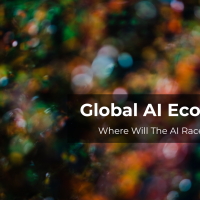My six year old son looks up from his dinner plate and asks, “Dad, in Star Wars does Darth Vader go back to the light side of the force?” For a moment I am taken back by his question. I enthusiastically think, “how insightful” for him to think about Darth Vader’s fate, “Did he get that thought from the movie?” In my geeked-out state I try remembering what had happened to Darth Vader before his death. I quickly bring myself back to reality, remember that my son is only six years old, and try not to “over-analyze” the simple question. I tell my son “yes, ultimately Darth Vader did go back to the light side of the force, after realizing his love and compassion for his son Luke was stronger than the power of the dark side.” My son was satisfied with the answer. After a few more mouthfuls of dinner my son went on to tell an elaborate story about Jedi’s, light sabers, the origins of the universe, and time travel. His eyes were wide as he lit up when talking about his rendition of Star Wars, a fictional movie that for all he knows could be a real as apple pie. What’s amazing is that my son has never fully watched the original Star Wars movies. He has, through some cosmic osmosis, pieced together the main elements of the storyline. Equal credit should be given to George Lucas for creating a story which lasts; and for commercial giants like LEGO and Disney which have creatively taken a timeless story and invigorated it for the next generation in new toys, games, movies and television shows.
My six year old son knows nothing about cassette tapes, Walkman’s, VCRs, dial-up Internet, xerography, record players, MS-DOS, or MTV. In fact, these once shiny and cool new innovations may also be a distant memory for those of us that grew up with them. Although technology comes and goes, the power of imagination, the spirit of innovation, and desire to evolve never gets old. Imagination coupled with ingenuity and hard work spark technological change. In fact, looking back on innovation, what we once thought of as science fiction has become our reality. Futuristic movies and books like Star Wars, Star Trek, Fahrenheit 451, 1984, and 2001: A Space Odyssey has planted seeds within millions of people which have sprouted novel ideas and products that now transcended generations.
The first Star Wars movie was released in 1977 and nearly 38 years later it continues to captivate our youth’s imagination. Although humans do not yet have light sabers, Jedi skills, or spacecraft capable of hyperspace, we seem determined to push ourselves until we get there.
Recent disclosure of the U.S. Navy’s deployment of a prototype 30-kilowatt-class Laser Weapon System aboard the amphibious transport ship, USS Ponce, in the Persian Gulf for testing is one signal that humans continue to push the limits of technology for destructive and peaceful means. Lasers were once ideas and conceptual algorithms written within the notebooks of research physicists.
Today lasers are in medical, retail, telecommunication, gaming, military, intelligence, security, manufacturing, and entertainment applications. Lasers have led to advancements in 3D printed metals, polymers, and other materials for a diversity of applications ranging from aerospace to fashion. This kind of leading edge use of lasers in manufacturing is supporting innovation in companies like Nike and GE as they evolve their products and manufacturing environments to be more efficient, resilient, and sustainable. Another signal of human ambition reflects the enormous economic costs and impact on human life we are willing to incur to pursue our Star Wars fantasy.
On October 31, 2014, SpaceShipTwo, the Virgin Galactic spacecraft that cost an estimated $400 million to develop, crashed over the Mojave desert in California, killing one of the two pilots. Richard Branson, founder of Virgin Galactic told the media that the company would learn from the tragic event, however that he would also “like to see the dream [for humans to experience commercial space flight] living on.”
It seems we cannot leave well enough alone. We push the limits of science, technology, and the human spirit. We seek to conquer our fear of the unknown. In the process we tinker, meddle, and compete. But our unrestrained sense of wonder and fascination occasionally yields welcomed surprises. Our achievements in advancing science and technology have brought us places we never thought possible and have deepened our knowledge of the earth and the universe so that we may come to understand the origins of life, and pursue more intimate relationships our physical and metaphysical world.
Anthro-Eco-Bio-Stellular-Tech-Droid Convergence
We now occupy the “Anthro-Eco-Bio-Stellular-Tech-Droid Convergence,” a schizophrenic reality where science fiction and social needs collide with each other. The upside of this convergence is that right now, more than any other time in history, we have the knowhow, capabilities, and technology to solve some of the world’s toughest challenges impacting human health and the environment. The downside is that we simply don’t know where to begin, or how best to mobilize and direct our intellect and resources in a manner where everyone wins.
An underlying question remains. “Why?” and not just the philosophical question of “why are we here?,” but “why do we feel compelled to pursue, let alone discover, the answer to this question in the first place?” The origins of life and fate of humans is an enigma. Ultimately we are our own worst enemy. On one hand we push the limits of science and space allowing our inner child to self-realize a rendition of George Lucas’s space opera. On the other hand we are social and emotional creatures desiring love, compassion, and interaction. We want truth and have an innate need for survival. We will stop at nothing to achieve both. The challenge for this generation is to reconcile our technological capability with the collective will, intellect, and needs of 7+ billion people on earth. After 10 years of space navigation and at a cost of $1.58B we can land a robot probe (Philae) on a comet (Rosetta) which travels at speeds up to 135,000 km/h, yet we struggle to mobilize on critical concerns closer to home: curtailing greenhouse gas emissions in the face of global climate change, eradicating global poverty and hunger, ending human trafficking, and defeating a host of diseases from cancer, to multiple sclerosis, AIDS and Ebola.
This is not to say that there are not millions of people dedicated to “home-based” missions of enormous consequence; there are. This is also not to suggest that humanity should not have Richard Branson’s who dream and bet big on humanity’s future; we definitely need them. The point here is that we need, borrowing from George Lucas, to strike a “balance in the force.” Scientists are predicting that the earth will get warmer and more populated in the next few decades. The projected impacts are bleak: dramatic shifts in weather patterns, increased intensity and severity of storms and natural hazards, and more constraints on life-critical infrastructure and natural resources including energy, water, and food.
There is no shortage of needs which we should funnel our creativity and intellect toward addressing. The challenge is for this generation to prioritize our needs from our wants, individually, and as a collective society. Embrace the “Anthro-Eco-Bio-Stellular-Tech-Droid Convergence,” for it is an amazing time to be alive. As we develop a more resilient built-environment, deploy robots in deep space, maneuver drones to deliver our mail, and mimic nature to design more sustainable products, we will also continue to evolve a deeper understanding of ourselves, and our place in the universe. But let’s also not forget about our underlying responsibility, to be conscious stewards of our place and time on earth. The fate of the earth and humanity are one in the same. Only by working together can we bring back a balance to the force. Together we must rediscover the power of trust, prioritize our collective goals, and jointly pursue a sustainable future.
Mark Coleman is a recognized voice, business advisor and consultant on the convergence of sustainability, environmental stewardship, energy, technology, and innovation.
Mr. Coleman is an active blogger with the Huffington Post, and has published numerous articles with leading organizations including GreenBiz.com, Environmental Leader, Triple Bottom Line Magazine, among others.
Mr. Coleman is the President of Convergence, Mitigation, Management (CMM) LLC, which provides custom business intelligence and advisory services for business, government, applied research, not-for-profit, and non-governmental organizations.
Mr. Coleman has advised hundreds of organizations in the areas of sustainability, risk, innovation, operational effectiveness, and business strategy. Much of this work led Mr. Coleman to write and publish two books, Time To Trust: Mobilizing Humanity for a Sustainable Future (Motivational Press 2014, www.timetotrustbook.com) and The Sustainability Generation: The Politics of Change and Why Personal Accountability is Essential NOW! (SelectBooks 2012, www.thesustainabilitygeneration.com) both of which highlight his perspective on holistic systems-level logic and theory for advancing humanity beyond the status-quo toward more integrated and mutual models of sustainable development.
Mr. Coleman currently serves on the board of the Sustainable Manufacturer Network (http://sustainablemfr.com/), and on the board of a not-for-profit organization, B9 Plastics (www.b9plastics.org) involving global water development concerns.
Mr. Coleman resides in the Finger Lakes region of New York with his wife Aileen and two sons, Owen and Neal.
Web:
Website: www.timetotrustbook.com
Twitter: @TheSustainGen










